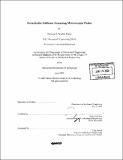Switchable stiffness scanning microscope probe
Author(s)
Mueller-Falcke, Clemens T. (Clemens Tobias)
DownloadFull printable version (10.35Mb)
Other Contributors
Massachusetts Institute of Technology. Dept. of Mechanical Engineering.
Advisor
Sang-Gook Kim.
Terms of use
Metadata
Show full item recordAbstract
Atomic Force Microscopy (AFM) has rapidly gained widespread utilization as an imaging device and micro/nano-manipulator during recent years. This thesis investigates the new concept of a dual stiffness scanning probe with respect to biological applications and determines the resulting requirements for the scanning of soft bio samples, such as low-pressure contact. On this basis, an in-plane AFM probe that is specifically tailored to the needs of biological applications is developed. It features a variable stiffness, which makes the stiffness of the probe adjustable to the surface hardness of the sample, and a very low overall stiffness, which is needed in order to achieve high resolution imaging. The switchable stiffness probe allows the scanning of biological samples with varying surface hardness without changing probes during scanning, and therefore prevents a loss of positional information, as is unavoidable with conventional devices. For the integration of the components into a MEMS device, the conventional cantilever-type design of AFM probes has been abandoned in favor of an in-plane design. The new design has an advantage in that it facilitates a high-density array of AFM probes and allows for easy surface micromachining of the integrated device. It also enables the future integration of micro-fluidic channels for reagent delivery and nanopipetting. For the scanning of nano-scale trenches and grooves, a multi-walled carbon nanotube, embedded in a nanopellet, is planned as a high-aspect-ratio tip. The variable stiffness is accomplished in a mechanical way by engaging or disengaging auxiliary beams to the compliant beam structure by means of electrostatically actuated clutches. (cont.) For actuation, an electrostatic combdrive is considered to move the probe tip up and down. The vertical displacement of the tip can be measured by a capacitive sensor, which can easily be integrated into the system. A scaled-up proof-of-concept model is manufactured with surface-micromachining processes. The clutch performance is successfully tested and the dual stiffness concept is verified by measuring the stiffness of the device with the clutches engaged and disengaged.
Description
Thesis (S.M.)--Massachusetts Institute of Technology, Dept. of Mechanical Engineering, 2005. Includes bibliographical references (p. 77-80).
Date issued
2005Department
Massachusetts Institute of Technology. Department of Mechanical EngineeringPublisher
Massachusetts Institute of Technology
Keywords
Mechanical Engineering.